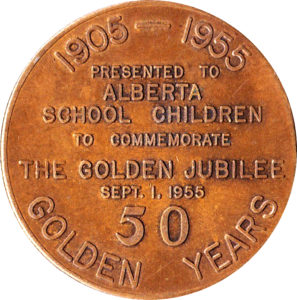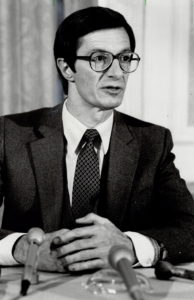Updated 16 December 2020
The final instalment in the Jim Dinning- Lou Hyndman memo prepared as background for a forthcoming budget- presumably 1980-81. The first part of these excerpts compare spending of the 50th anniversary celebration of Alberta’s entry into confederation as a province with spending proposed for the 1980 – 75th celebrations.

in addition, these excerpts from budgets in the 1950s, 1960s, and 1970 reflect perennial concerns of provincial treasurers: the constant spending pressures and the use of non-renewable resource revenues to fund the appetite for education, municipal, highways, and health services.
These budgets including the final budget of the Social Credit government are full of admonishments towards spending beyond our means and the perils of debt and Canada’s monetary system. 
One is left with the impression that there was a greater willingness on the part of the Treasurers and greater latitude for treasurers to talk more honestly about pressures they faced when trying to reconcile the demand for greater spending within the resources of the revenue. Seventy-years ago Treasurers were decidedly worried about the dangers of over-reliance on non-renewable resource revenue. One gets the impression that this over-reliance was also on the minds of Treasurer Hyndman and his Executive Assistant, Dinning.

BUDGET ADDRESSES
1955 – March 4
Treasurer C.E. Gerhart presented this address to the Assembly.

Mr. Gerhart spoke glowingly of the concurrent service of Mr. Manning as both Premier and provincial treasurer. Including his remarks of Praise, he said, “ More towards this end could not have been done by any one man within the restrictive framework of our present monetary system.”
50th Anniversary Celebrations
1955 was the province’s 50th birthday. The two auditoria were built in celebration of this event. The 1955 budget showed the expenditure on these two buildings at $2.5 million, 1.6% of the province’s 1955-6 operating budget or 1.09% of the total budget for that year. (This $2.5 million figure does not include costs of celebrations over and above the Jubilee Auditoria.
50th Anniversary Celebrations
The $75 Million expenditure for Alberta’s 1980 celebrations is 1.6% of our 1979-80 total budget of $4.58 billion for 1.4% of the 1980-81 proposed budget of $5.3 billion.
Jubilee Auditoria
Increasingly enough, more than $2.5 million was spent on the two auditoria in Edmonton and Calgary. Budgets for 1956, 1957 and 1958 showed capital estimates in the public works department for the auditorium in the sums of $3.56 million, $1.0 million and $0.13 million, respectively.
Comparisons
In a 75th Anniversary section, you might make some comparison similar to those found on the attached page found in the 1955 budget. Comparable topics might include population, total budget, value of Agriculture mineral resources production, number of schools and hospitals, etc.
Public Debt
By 1955, the total provincial debt stood at just over $90 million. At March 31, 1936, this figure stood at $167 million. As a result, it was reduced by merely 75 million or 45% in an eight- year (sic) period.
Education
In 1955, the largest departmental appropriation was for the Department of Education – $34 million or nearly 30% of the total estimated expenditures. This was a 54% or $12 million-increase over the previous year’s estimate of $22.3 million.
The grant to the University of Alberta was increased from .$1.7 million to $1.86 million.
Government Financing of Medical Costs
To backup the changes in medical care financing, you might offer a detailed breakdown of those Health Services Finance by the provincial treasury, as Mr Gerhart get in his 1955 address. ( See his chart on the attached page.- See a bottom of article.)
During the fifties and sixties the Socreds were big on detailing in chart form the assistance provided by the Province to its municipalities. You might consider doing the same thing for one or two areas, including municipalities, senior citizens, Education, Health Services, etc
1960
This budget speech was delivered to the Legislature by Hon. E. W. Hinman.

Philosophy of Budgetting (sic)
In speaking to the problem of ever-increasing annual budgets, Mr. Hinman said, “ And so it is that budgeting becomes a business of allocating priorities to desirable projects and services and providing for the maximum number which can be paid for from the revenues anticipated. The budget that I am presenting to you tonight has been prepared with a constant awareness of that philosophy which abhors debt at times of prosperity, which regards inflation as the most malicious of all taxes, which attributes to our people the moral fortitude, the energy, the initiative and intelligence to improve steadily our standard of living without exploiting our non-renewable resources or mortgaging the economic future of successive governments.”
Q & M Pipeline
Today, there is in the planning stages a pipeline that will carry our natural resources to beyond Montreal to the Maritimes. Mr. Hinman stated in 1960, “In a preliminary report, .The Royal Commission on Energy Resources stated that while they did not consider it economic at present for a pipeline to be built to Montreal, they did think that the oil companies could develop much Raider markets for Western Canadian Oil within the area presently served by pipelines.”
1960-61 Budget
1960 – 61 estimates proposed operating expenditures of $256.4 million, Capital expenditures of $85.2 million for a total budget of $341.6 million. Education and highways expenditures accounted for over 25% and 21% respectively of the total budget. Public Health and Welfare meet up over 28% of the total budget.
1970
This speech was delivered to the Assembly by the Hon. A.O. Aalborg, Provincial Treasurer.
$ Billion Budget
This was Alberta’s first billion dollar budget – $1.146 billion, an increase of 17% over the previous year. The overall budget( operating and capital) was a deficit budget requiring borrowings and withdrawals from reserves in the amount of $112.8 million. Mr. Aalborg expressed concern over this and past deficits stating, “rising expenditures continue to exceed increases in revenues from present sources. In all previous budgets that I have presented to this Assembly I have called attention to this disturbing trend and I must again strongly emphasize that if the rate of acceleration of these expenditures is not sharply reduced in future years, their growing magnitude will quickly outstrip all revenues available to the Province from present and potential sources. Pressures and demands for additional funds for a constantly growing variety of purposes are louder and more insistent at any previous time in our history.”
Alarming Rate of Expenditures
The Treasurer brought home the accelerating rate of expenditures by making comparisons with the previous “00-01” fiscal years. FOr instance:
“Mr. Speaker, a few comparisons with Budgets of the past will bring the magnitude of the Budget for the fiscal year ahead into proper perspective and illustrate the need for further firm restraints in order to keep the financial affairs of the Province in a sound and healthy condition.”
1950-51 Budget

In 1950-51 our total budget was less than $100,000,000 and included less than $13,000,000 for education.
1960-61 Budget.
Our record-breaking $1 billion plus budget for the next fiscal year, 1970-71 is about three and one-half times as great as the budget of $328.6 million for the fiscal year 1960-61 at the beginning of the last decade, and more than double our budget of $493.7 million for 1965-66 only 5 years ago.
Education 1960 Budget
Total estimated expenditures for education in our budget for 1970-71 in the amount of approximately $404 million are about $75 million greater than our total Budget at the beginning of the last decade.”
Mr. Aalborg made reference to the opening of the Alberta Resources Railway, built at a “ final cost well within $100 million” on May 28th, 1969. “This will make a tremendous contribution to the further economic development of the province during the 1970s.”
The Treasurer addressed four functional areas in his speech: development of human resources, development of physical resources, general administration and financial administration.
Education
Education received by far the most funding for the 1970-71 fiscal year. Total estimated expenditure of $404.6 million represented nearly 35% of the total budget.
Once again, a special section was devoted to financial assistance to local authorities. You might consider this for health services, education, senior citizens, farmers/agriculture, etc.
The 70s Decade
In his conclusion, the Treasurer made reference to the entry into a new decade by saying, “In presenting our first annual budget for the 1970’s we are convinced that this new decade holds in store a great new era of progress and achievement for Alberta. Few regions of the world have the enormous potential for further development found in our Province. If conditions and events beyond our borders and beyond our control of the national and international scene, such as inflation, do not hamper or curtail social and economic advancement in Alberta, the 1970’s will be the most fruitful decade in our history since Alberta join Confederation in 1905.”
Terrific Foreshadowing
You could easily make reference to this” Weis prediction” of Mr. Aalborg coin chain hell how right he was given that Albertans chose to call upon Premier Lougheed and his colleagues to lead us through the 1970’s.
Mr. Aalborg also expressed concern over the economic condition throughout Canada. “ As we enter the 1970’s Premier Strom’s Social Credit Government is deeply concerned over the plight and financial needs of many citizens in Alberta and in all parts of Canada which have resulted from inflation, high interest rates and sharp increases in the cost of living.”
Additional Comments
1952: Management of Resources & Revenues
In 1952, Mr Manning expressed the proper management of our vast natural resources and the revenues accruing as a result. It is an interesting reference, parts of which could be updated and use in 1980-81:
“ Within this province, we are fortunate in that circumstances enable us to offset to a large degree the impact of these national disabilities on our provincial economy. Through the orderly development of the vast natural resources with which we are blessed, we have been able to obtain a high standard of provincial prosperity. If, as a province, we adhere to policies which ensure the continued and still greater development of those resources, the new wealth stemming from such development can be an effective bulwark against many of the economic ills which stem from the chronic defects in the national monetary system. Since the Leduc discovery well came into production in February of 1947, the public treasury of this province has received as a direct result of oil and gas development as at January 31, 1954, $271.9 million which is over $34 million more than the total amount paid by all the people of Alberta in municipal, school and hospital tax taxes combined during the same period. For the present year, revenues from oil will exceed $90 million which is one and a half times the total of all municipal, school and hospital taxes paid by 1953. By the end of the present year, revenues from oil and gas development will have doubled almost four times since the fiscal year of 1948 49 when revenue from oil first become a major factor in our provincial economy”
1957: Boom can not continue
In 1957, Provincial Treasurer, E. W. Hinman spoke of the present boom in the economy. “ I have not found a single economist of repute who is ready to say that our boom will continue indefinitely. I have read the warnings of many that inflation, uncontrolled, must inevitably lead to depression. We are advised as individuals to spend less and save more, to get out of debt rather than into debt for non-productive purposes. This budget reflects the fact that the government is conscious of its responsibilities. We have planned to increase our reserves against the possibility of a falling economy and greater need for regulatory government policies in relation to capital expenditures, social services, assistance to municipalities, maintenance of pension payments of all kinds and control of the availability of credit as far as we may be able.”
1958: Demand for Gov’t Services & Resultant Costs
The following year, 1958, Treasurer Hinman spoke again of the prosperity but warned against the increasing presence of government in our daily lives:
“Nowhere in Canada can there be found a people who enjoy so high a standard of public service at so little personal cost and with so little public indebtedness at provincial level. In all other province are the people so well secured against the possible necessity of last name public service, for we have in Alberta reserves which amount to almost three hundred dollars per capita.”
It is earnestly hoped many Albertans will study the information provided to you tonight and we’ll come to realize how very much each of us is subsidized at public expense in our way of living and how important it is that we be guided by reason and moderation. We must see that our demands on the one and our willingness to contribute on the other shall not make it impossible for us to enjoy in perpetuity the benefits which can be ours through democratic association without any sacrifice of our personal rights to be highly individualistic in a land where freedom is abundant.”
1959: Dependence on N.R.R.R.
In 1959, the Treasurer again brought home our dependence on oil and gas revenues. “ I cannot help reminding members of this Assembly that have the Government in past years used any major part of our oil Revenue to defray the ordinary costs of Government, provincial and municipal, we should have been faced this year with the necessity of cutting back our services and grants, of borrowing money for operating purposes, or of seeking larger revenue through new taxation.” What he is saying here is that the Socreds attempted to use this revenue from non-renewable resources to pay for capital costs as well as retiring public debt.
JFD/kaz
Gerhart-1955-56-budget